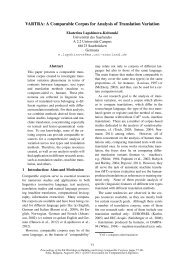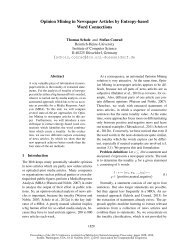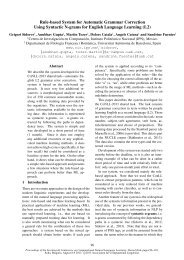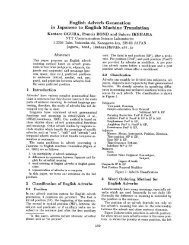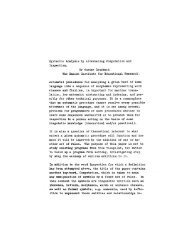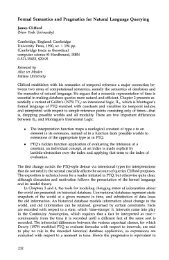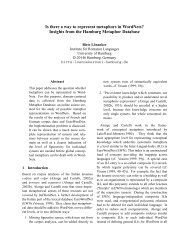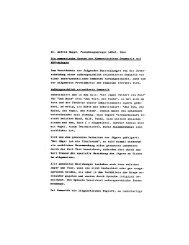Vector Space Semantic Parsing: A Framework for Compositional ...
Vector Space Semantic Parsing: A Framework for Compositional ...
Vector Space Semantic Parsing: A Framework for Compositional ...
You also want an ePaper? Increase the reach of your titles
YUMPU automatically turns print PDFs into web optimized ePapers that Google loves.
[ ]<br />
W1 ∗ , W2 ∗ , A ∗ u 1<br />
, ..., A ∗ v 1<br />
, ... = arg min ||atanh(P T [Au1 ⃗v 1 , ..., A uk ⃗v k ]<br />
) − [W 1 , W 2 ]<br />
|| F<br />
R m×m [A v1 ⃗u 1 , ..., A vk ⃗u k ]<br />
= arg min ||atanh(P T ) − W 1 [A u1 ⃗v 1 , ..., A uk ⃗v k ] − W 2 [A v1 ⃗u 1 , ..., A vk ⃗u k ]|| F<br />
R m×m<br />
Figure 1: Fulllex estimation problem.<br />
words), namely determiners. It is a multiplechoice<br />
test where target nouns (e.g., amnesia)<br />
must be matched with the most closely related<br />
determiner(-noun) phrases (DPs) (e.g., no memory).<br />
The task differs from the previous one also<br />
because here the targets are single words, and the<br />
related items are composite. There are 173 target<br />
nouns in total, each paired with one correct<br />
DP response, as well as 5 foils, namely the determiner<br />
(no) and noun (memory) from the correct<br />
response and three more DPs, two of which contain<br />
the same noun as the correct phrase (less memory,<br />
all memory), the third the same determiner<br />
(no repertoire). Other examples of targets/relatedphrases<br />
are polysemy/several senses and trilogy/three<br />
books. The models compute cosines between<br />
target noun and responses and are scored<br />
based on their accuracy at ranking the correct<br />
phrase first.<br />
4.2 Input vectors<br />
We extracted distributional semantic vectors using<br />
as source corpus the concatenation of ukWaC,<br />
Wikipedia (2009 dump) and BNC, 2.8 billion tokens<br />
in total. 7 We use a bag-of-words approach<br />
and we count co-occurrences within sentences and<br />
with a limit of maximally 50 words surrounding<br />
the target word. By tuning on the MEN lexical<br />
relatedness dataset, 8 we decided to use the top<br />
10K most frequent content lemmas as context features<br />
(vs. top 10K inflected <strong>for</strong>ms), and we experimented<br />
with positive Pointwise and Local Mutual<br />
In<strong>for</strong>mation (Evert, 2005) as association measures<br />
(vs. raw counts, log trans<strong>for</strong>m and a probability<br />
ratio measure) and dimensionality reduction by<br />
Non-negative Matrix Factorization (NMF, Lee and<br />
Seung (2000)) and Singular Value Decomposition<br />
(SVD, Golub and Van Loan (1996)) (both outper<strong>for</strong>ming<br />
full dimensionality vectors on MEN). For<br />
7 http://wacky.sslmit.unibo.it;<br />
http://www.natcorp.ox.ac.uk<br />
8 http://clic.cimec.unitn.it/ ∼ elia.<br />
bruni/MEN<br />
both reduction techniques, we varied the number<br />
of dimensions to be preserved from 50 to 300 in<br />
50-unit intervals. As Local Mutual In<strong>for</strong>mation<br />
per<strong>for</strong>med very poorly across composition experiments<br />
and other parameter choices, we dropped<br />
it. We will thus report, <strong>for</strong> each experiment and<br />
composition method, the distribution of the relevant<br />
per<strong>for</strong>mance measure across 12 input settings<br />
(NMF vs. SVD times 6 dimensionalities). However,<br />
since the Mult model, as expected, worked<br />
very poorly when the input vectors contained negative<br />
values, as is the case with SVD, <strong>for</strong> this<br />
model we report result distributions across the 6<br />
NMF variations only.<br />
4.3 Composition model estimation<br />
Training by approximating the corpus-extracted<br />
phrase vectors requires corpus-based examples of<br />
input (constituent word) and output (phrase) vectors<br />
<strong>for</strong> the composition processes to be learned.<br />
In all cases, training examples are simply selected<br />
based on corpus frequency. For the first experiment,<br />
we have 42 distinct target verbs and a total<br />
of ≈20K training instances, that is, 〈〈noun, verb〉,<br />
noun-verb〉 tuples (505 per verb on average). For<br />
the second experiment, we have 479 adjectives and<br />
≈1 million 〈〈adjective, noun〉, adjective-noun〉<br />
training tuples (2K per adjective on average). In<br />
the third, 50 determiners and 50K 〈〈determiner,<br />
noun〉, determiner-noun〉 tuples (1K per determiner).<br />
For all models except Lexfunc and Fulllex,<br />
training examples are pooled across target elements<br />
to learn a single set of parameters. The<br />
Lexfunc model takes only argument word vectors<br />
as inputs (the functors in the three datasets are<br />
verbs, adjectives and determiners, respectively). A<br />
separate weight matrix is learned <strong>for</strong> each functor,<br />
using the corresponding training data. 9 The<br />
Fulllex method jointly learns distinct matrix representations<br />
<strong>for</strong> both left- and right-hand side con-<br />
9 For the Lexfunc model we have experimented with least<br />
squeares regression with and without regularization, obtaining<br />
similar results.<br />
55



